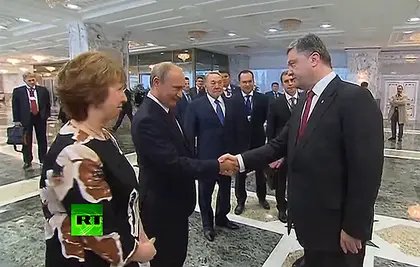Poroshenko spoke to Putin on the phone on Sept.3, according to a statement on the president’s website. “As a result of this conversation, an agreement was reached on a permanent ceasefire in Donbas. An agreement was reached about mutual vision of steps that will promote peace,” the press statement said.
Peskov said earlier in the day that Putin and Poroshenko in a recent conversation discovered that they “largely share views” on peace solutions in Ukraine’s east. He said, however, the President Vladimir Putin did not agree to a ceasefire because Russia is not a party in Ukraine’s conflict.
JOIN US ON TELEGRAM
Follow our coverage of the war on the @Kyivpost_official.
The new agreement comes as a surprise because the presidents could not agree on common solutions to the problems in the east during their two-hour discussion in Minsk on Aug. 26.
Ukraine has accused Russia of sending troops and weapons to the east, which Russia has denied. Ukraine’s National Security and Defense Council spokesman said that Russian regular troops, often without insignias, have been seen in at least 10 different towns and cities in eastern Ukraine by Sept. 2.
It was not immediately clear whether fighting, which has claimed more than 2,600 lives of Ukrainian civilians and soldiers, was being observed on the ground where fighting is fiercest – in Luhansk and Donetsk oblasts.
The announcement also comes a day ahead of the start of a NATO summit in Wales at which the 28-nation military alliance was set to announce tougher military defense to Russia’s aggression. It also comes as the European Union and America are considering tougher sanctions against the Kremlin, including individuals and companies.
Timothy Ash, who heads emerging market research for Standard Bank in London, was skeptical.
“Let’s see if this holds. Poroshenko will have to deliver on Putin’s agenda, and I really struggle to see how that can be sold domestically in Ukraine ahead of parliamentary elections in October,” Ash wrote. “I guess for the Ukrainian military this gives them a chance to regroup after recent military setbacks, and bide time to see what NATO and the EU delivers over the next few days in terms of deterrents to Russia for further intervention. In the past we have seen Moscow looking to talk/sending peace signals just before important EU/G7/NATO meetings, and presumably to weaken momentum towards sanctions/countermeasures. Subsequently we then saw further intervention and escalation. Ultimately, getting a lasting agreement will be difficult, while the two sides longe- term objectives are just so far apart – Ukraine wants a Western orientation, and Moscow is looking to stop/block that.”
You can also highlight the text and press Ctrl + Enter



